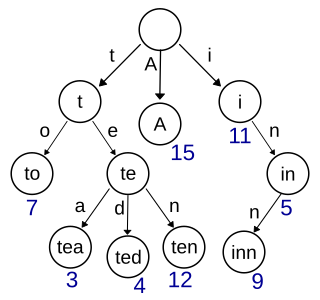Information retrieval (IR) in computing and information science is the task of identifying and retrieving information system resources that are relevant to an information need. The information need can be specified in the form of a search query. In the case of document retrieval, queries can be based on full-text or other content-based indexing. Information retrieval is the science of searching for information in a document, searching for documents themselves, and also searching for the metadata that describes data, and for databases of texts, images or sounds.
In computer science, string-searching algorithms, sometimes called string-matching algorithms, are an important class of string algorithms that try to find a place where one or several strings are found within a larger string or text.

In computer science, a trie, also called digital tree or prefix tree, is a type of search tree: specifically, a k-ary tree data structure used for locating specific keys from within a set. These keys are most often strings, with links between nodes defined not by the entire key, but by individual characters. In order to access a key, the trie is traversed depth-first, following the links between nodes, which represent each character in the key.

In linguistics, Heaps' law is an empirical law which describes the number of distinct words in a document as a function of the document length. It can be formulated as

In computer science, a suffix tree is a compressed trie containing all the suffixes of the given text as their keys and positions in the text as their values. Suffix trees allow particularly fast implementations of many important string operations.
In computer science, a suffix array is a sorted array of all suffixes of a string. It is a data structure used in, among others, full-text indices, data-compression algorithms, and the field of bibliometrics.
The bitap algorithm is an approximate string matching algorithm. The algorithm tells whether a given text contains a substring which is "approximately equal" to a given pattern, where approximate equality is defined in terms of Levenshtein distance – if the substring and pattern are within a given distance k of each other, then the algorithm considers them equal. The algorithm begins by precomputing a set of bitmasks containing one bit for each element of the pattern. Then it is able to do most of the work with bitwise operations, which are extremely fast.

Ricardo A. Baeza-Yates is a Chilean computer scientist that currently is the Director of Research of the Institute for Experiential AI at Northeastern University in the Silicon Valley campus. He is also part-time professor at Universitat Pompeu Fabra in Barcelona and Universidad de Chile in Santiago. He is an expert member of the Global Partnership on Artificial Intelligence, a member of the Association for Computing Machinery's US Technology Policy Committee as well as IEEE's Ethics Committee.
In computer science, an inverted index is a database index storing a mapping from content, such as words or numbers, to its locations in a table, or in a document or a set of documents. The purpose of an inverted index is to allow fast full-text searches, at a cost of increased processing when a document is added to the database. The inverted file may be the database file itself, rather than its index. It is the most popular data structure used in document retrieval systems, used on a large scale for example in search engines. Additionally, several significant general-purpose mainframe-based database management systems have used inverted list architectures, including ADABAS, DATACOM/DB, and Model 204.

In computer science, approximate string matching is the technique of finding strings that match a pattern approximately. The problem of approximate string matching is typically divided into two sub-problems: finding approximate substring matches inside a given string and finding dictionary strings that match the pattern approximately.
Search engine indexing is the collecting, parsing, and storing of data to facilitate fast and accurate information retrieval. Index design incorporates interdisciplinary concepts from linguistics, cognitive psychology, mathematics, informatics, and computer science. An alternate name for the process, in the context of search engines designed to find web pages on the Internet, is web indexing.
A web query or web search query is a query that a user enters into a web search engine to satisfy their information needs. Web search queries are distinctive in that they are often plain text and boolean search directives are rarely used. They vary greatly from standard query languages, which are governed by strict syntax rules as command languages with keyword or positional parameters.
In computer science, the all nearest smaller values problem is the following task: for each position in a sequence of numbers, search among the previous positions for the last position that contains a smaller value. This problem can be solved efficiently both by parallel and non-parallel algorithms: Berkman, Schieber & Vishkin (1993), who first identified the procedure as a useful subroutine for other parallel programs, developed efficient algorithms to solve it in the Parallel Random Access Machine model; it may also be solved in linear time on a non-parallel computer using a stack-based algorithm. Later researchers have studied algorithms to solve it in other models of parallel computation.
The term compressed data structure arises in the computer science subfields of algorithms, data structures, and theoretical computer science. It refers to a data structure whose operations are roughly as fast as those of a conventional data structure for the problem, but whose size can be substantially smaller. The size of the compressed data structure is typically highly dependent upon the information entropy of the data being represented.
In computer science, a compressed suffix array is a compressed data structure for pattern matching. Compressed suffix arrays are a general class of data structure that improve on the suffix array. These data structures enable quick search for an arbitrary string with a comparatively small index.

An infobox is a digital or physical table used to collect and present a subset of information about its subject, such as a document. It is a structured document containing a set of attribute–value pairs, and in Wikipedia represents a summary of information about the subject of an article. In this way, they are comparable to data tables in some aspects. When presented within the larger document it summarizes, an infobox is often presented in a sidebar format.
In data mining, intention mining or intent mining is the problem of determining a user's intention from logs of his/her behavior in interaction with a computer system, such as in search engines, where there has been research on user intent or query intent prediction since 2002 ; and commercial intents expressed in social media posts.

Gad Menahem Landau is an Israeli computer scientist noted for his contributions to combinatorial pattern matching and string algorithms and is the founding department chair of the Computer Science Department at the University of Haifa.

Martin Farach-Colton is an American computer scientist, known for his work in streaming algorithms, suffix tree construction, pattern matching in compressed data, cache-oblivious algorithms, and lowest common ancestor data structures. He is the Leonard J. Shustek Professor of Computer Science and chair of the Department of Computer Science and Engineering at New York University. Formerly, he was a Distinguished Professor of Computer Science at Rutgers University. He co-founded the storage technology startup company Tokutek.
Jewels of Stringology: Text Algorithms is a book on algorithms for pattern matching in strings and related problems. It was written by Maxime Crochemore and Wojciech Rytter, and published by World Scientific in 2003.







